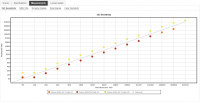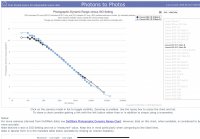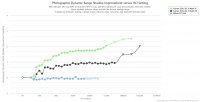I am not an expert in how to interpret DxO scores. Does anyone know why the 1DX3 would score less than the 1DX2 (83 vs 88)? And even lower than the a9ii (93) and a7RIV (99)? I don't see how this makes sense.
You are using an out of date browser. It may not display this or other websites correctly.
You should upgrade or use an alternative browser.
You should upgrade or use an alternative browser.
Canon 1DX3 DxO Scores
- Thread starter neurorx
- Start date
There is already a thread on this.
 www.canonrumors.com
www.canonrumors.com
Believing in scores - or not
DXO posted it´s sensor score on the 1DX III. https://www.dxomark.com/canon-eos-1d-x-mark-iii-sensor-review For my friends, who own this new body, the score is rubbish. They report the III is better than the II in low light situations and noise too. So, believe in this score - or not. My...
Upvote
0
I am not an expert in how to interpret DxO scores. Does anyone know why the 1DX3 would score less than the 1DX2 (83 vs 88)? And even lower than the a9ii (93) and a7RIV (99)? I don't see how this makes sense.
Look at the measured ISO "sensitivities" at each setting. Either DxO's measurements are off, or Canon has decided to meter/expose everything about one stop to the right compared to everyone else (including previous Canon cameras), who tend to under amplify to protect highlights.

Upvote
0
Oh that’s easy, DxO are incompetent and biased and take years to correct their obvious mistakes and even then don’t actually acknowledge making them.I am not an expert in how to interpret DxO scores. Does anyone know why the 1DX3 would score less than the 1DX2 (83 vs 88)? And even lower than the a9ii (93) and a7RIV (99)? I don't see how this makes sense.
For another interpretation of DxO’s actual data just look here https://photonstophotos.net/Charts/PDR.htm it gives a very different point of view. The sensor on the MkIII is better than the MkII until you go into the highest iso numbers at which point the MkII RAW files are cooked and the MkIII files aren’t (the triangle).

Upvote
0
I don't know much about DXO's testing or whether its valid or not. It seems widely disliked here.
My comment is only a personal opinion after using it for 3 months.
The sensor on the 1DX III doesn't seem that special to me. I assume DXO is reflecting that.
It doesn't have any apparently improved dynamic range over the 1DX II, 5D IV in my use.
To be honest compared to a 5D IV and 5DSR 20 MP seems underpowered.
The buffer is so good I'd say it would have coped with a higher MP.
I bought the camera mainly for sport but there has been no sport unfortunately.
So its mainly been used for nature.
The camera is all about raw power.
The buffer is unfillable. Focusing is excellent but on small objects it struggles almost as much as any other camera.
Shooting a large object like a dog running its excellent. Chase a swallow round in circles it increases your odds but still struggles.
Small birds you need to be close as even though the focussing is on target you don't have that many MP's to work with.
It has excellent ergonomics, connectivity, battery life, robustness.
Just not a very special sensor in my singular opinion.
There was a standard argument in the past where less MP on a full frame sensor would sort of lead to better quality pixels but maybe we've gone beyond that.
If the 5R has the same focussing system and 45 MP it will probably make a better wildlife camera (bar battery life and buffer).
It will have a higher number of MP's on target and that matters with wildlife.
The 1DX III will remain the best for sport.
My comment is only a personal opinion after using it for 3 months.
The sensor on the 1DX III doesn't seem that special to me. I assume DXO is reflecting that.
It doesn't have any apparently improved dynamic range over the 1DX II, 5D IV in my use.
To be honest compared to a 5D IV and 5DSR 20 MP seems underpowered.
The buffer is so good I'd say it would have coped with a higher MP.
I bought the camera mainly for sport but there has been no sport unfortunately.
So its mainly been used for nature.
The camera is all about raw power.
The buffer is unfillable. Focusing is excellent but on small objects it struggles almost as much as any other camera.
Shooting a large object like a dog running its excellent. Chase a swallow round in circles it increases your odds but still struggles.
Small birds you need to be close as even though the focussing is on target you don't have that many MP's to work with.
It has excellent ergonomics, connectivity, battery life, robustness.
Just not a very special sensor in my singular opinion.
There was a standard argument in the past where less MP on a full frame sensor would sort of lead to better quality pixels but maybe we've gone beyond that.
If the 5R has the same focussing system and 45 MP it will probably make a better wildlife camera (bar battery life and buffer).
It will have a higher number of MP's on target and that matters with wildlife.
The 1DX III will remain the best for sport.
Last edited:
Upvote
0
To be honest compared to a 5D IV and 5DSR 20 MP seems underpowered.
Sounds like the 1DXIII wasn't intended for you.
Upvote
0
This kind of data is difficult for us, as consumers, to measure. However I have come across a DXOMark anomaly that is easy to measure; the transmission on two lenses, one which is an f/2 lens, and they rate it at 2 T stops, and another that is an f/1.8 lens and they rate it at 2.3 T stops. Now the difference between f/1.8 and 2.3 is about two thirds of a stop, so I thought the difference should be quite obvious. So I tested both lenses together, at varying apertures including wide open, and in two different light levels, about EV 14 and then about EV 6 with identical exposures to each other of course, with the exception of the wide open shots where I had the f/1.8 lens one third of a stop less exposure. To cut a long story short the f/1.8 lens, if there was any difference at all, was slightly brighter, definitely so at some apertures. So I don't know if it's the vignette that is effecting the T stop results, but whatever it is, in practice the two thirds less transmission proves to be b******s.
Upvote
0
According to photons to photos the 1DXIII has nearly flat ISO invariance above ISO 400 and is a significant improvement over the two previous IDX bodies. If you meter to protect the highlights you should be able to set the tone of the rest of the image to be pretty much anywhere you want without a noise penalty. Wasn't that the point? If that's not good enough I'm not really sure what you are looking for. As far as I'm concerned, Canon's DR is very competitive. CMOS sensors are never going to be able to capture the full range of available light in every possible scene. Develop a plan to deal with that and move on with your life.I don't know much about DXO's testing or whether its valid or not. It seems widely disliked here.
My comment is only a personal opinion after using it for 3 months.
The sensor on the 1DX III doesn't seem that special to me. I assume DXO is reflecting that.
It doesn't have any apparently improved dynamic range over the 1DX II, 5D IV in my use.
To be honest compared to a 5D IV and 5DSR 20 MP seems underpowered.
The buffer is so good I'd say it would have coped with a higher MP.
I bought the camera mainly for sport but there has been no sport unfortunately.
So its mainly been used for nature.
The camera is all about raw power.
The buffer is unfillable. Focusing is excellent but on small objects it struggles almost as much as any other camera.
Shooting a large object like a dog running its excellent. Chase a swallow round in circles it increases your odds but still struggles.
Small birds you need to be close as even though the focussing is on target you don't have that many MP's to work with.
It has excellent ergonomics, connectivity, battery life, robustness.
Just not a very special sensor in my singular opinion.
There was a standard argument in the past where less MP on a full frame sensor would sort of lead to better quality pixels but maybe we've gone beyond that.
If the 5R has the same focussing system and 45 MP it will probably make a better wildlife camera (bar battery life and buffer).
It will have a higher number of MP's on target and that matters with wildlife.
The 1DX III will remain the best for sport.
Here is the 1DXiii vs the A9ii. The Sony's use two amplification ranges but other wise the results are very similar. This had been the area where Sony sensors visibly outperformed Canon's and now there is very little difference.
Last edited:
Upvote
0
I’m not currently using it for its intended use due to Co-Vid 19. What I am saying is there is nothing special about its sensor. That also seems to be DXO’s conclusionSounds like the 1DXIII wasn't intended for you.
Upvote
0
++++ there is nothing special about its sensorI’m not currently using it for its intended use due to Co-Vid 19. What I am saying is there is nothing special about its sensor. That also seems to be DXO’s conclusion
A.M.: ISO in-variance up to ISO 1600 is not? that's up to 4 stop strong push from ISO 100 that does NOT increase shadow noise. ok.. can I have that in 5 series Canon body please?
Upvote
0
You can quote what you like but I don’t think the sensor is special. It is not a significant improvement on the older 1DX’s where low ISO was not an issue. From a practical perspective I would not see any noticeable improvement from the sensor. This is from taking thousands of images in all sorts of light. I think that is what DXO is reflecting. In terms of focusing FPS, and buffer its really good.According to photons to photos the 1DXIII has nearly flat ISO invariance above ISO 400 and is a significant improvement over the two previous IDX bodies. If you meter to protect the highlights you should be able to set the tone of the rest of the image to be pretty much anywhere you want without a noise penalty. Wasn't that the point? If that's not good enough I'm not really sure what you are looking for. As far as I'm concerned, Canon's DR is very competitive. CMOS sensors are never going to be able to capture the full range of available light in every possible scene. Develop a plan to deal with that and move on with your life.
[/URL]
Here is the 1DXiii vs the A9ii. The Sony's use two amplification ranges but other wise the results are very similar. This had been the area where Sony sensors visibly outperformed Canon's and now there is very little difference.
[/URL]
Upvote
0
Aussie shooter
https://brettguyphotography.picfair.com/
Its probably a realistic statement to say that from a 'practical' perspective you wont see any noticeable improvement from ANY top rate FF sensor. Sure. You may get technical improvements in a lab but no sensor is going to make your photos better any more. It clearly is not an issue in any FF camera from any brandYou can quote what you like but I don’t think the sensor is special. It is not a significant improvement on the older 1DX’s where low ISO was not an issue. From a practical perspective I would not see any noticeable improvement from the sensor. This is from taking thousands of images in all sorts of light. I think that is what DXO is reflecting. In terms of focusing FPS, and buffer its really good.
Upvote
0
It's a very good sensor and an improvement over that in the 1DXII for iso performance. But, according to photonsphotos it is not ISO-invariant from 100-1600 iso but noise increases in a 100-1600 push. Very few sensors are ISO-invariant in that range, a rare one being that of the Nikon 7200.++++ there is nothing special about its sensor
A.M.: ISO in-variance up to ISO 1600 is not? that's up to 4 stop strong push from ISO 100 that does NOT increase shadow noise. ok.. can I have that in 5 series Canon body please?

Upvote
0
Because the topic is similar I repeat here , what I wrote in this thread:
I believe in a tool, that I have in my hand and that I can use....
So, believe in [...] score - or not.
...
I believe in the output, that results in my skills to use this tool and in creativity.
If you take a closer look at such numerical "scores" you might find that they differ by less than 5%. Sometimes maybe more.
If you then compare this with your own eyes, you might be not able to see this 5% in test chart comparisons.
If you then think about how much % is left in your skills, creativity and patience to improve your output, maybe you come to the same conclusion as I did:
"It's me! It's me that can improve the image quality much more than some new gear."
And:
"Even if that piece of gear is 5 to 10% better, I still have to have the ability to squeeze that out of that better tool!"
So forget about charts and scores, go out enjoy the gear that you have and the pics you take with it, and if you feel limited by it and have the money, spend it...
Upvote
0
Similar threads
- Contains 1 staff post(s)
- Replies
- 57
- Views
- 30K
- Replies
- 24
- Views
- 6K
- Replies
- 15
- Views
- 4K
- Replies
- 28
- Views
- 11K
